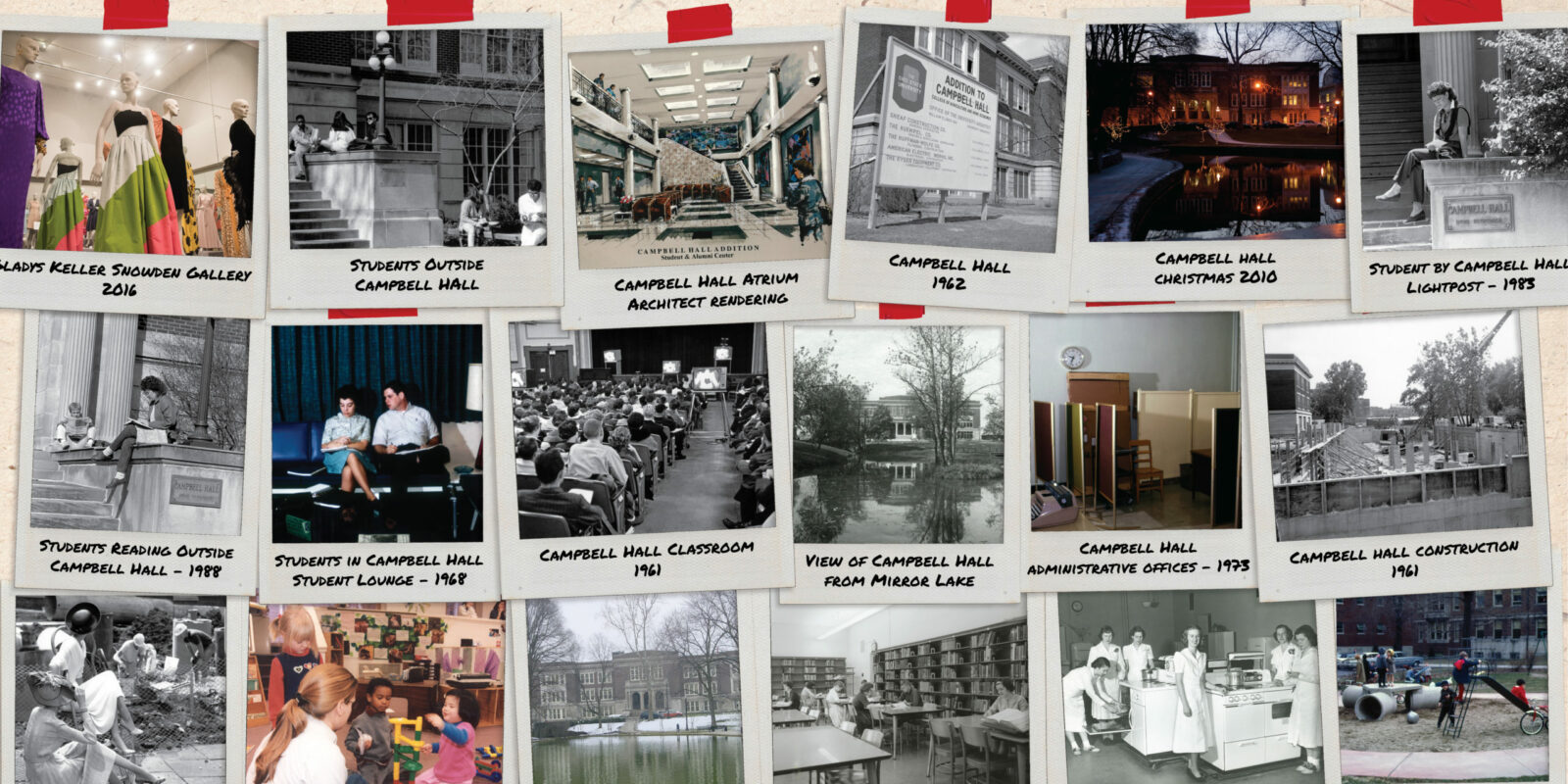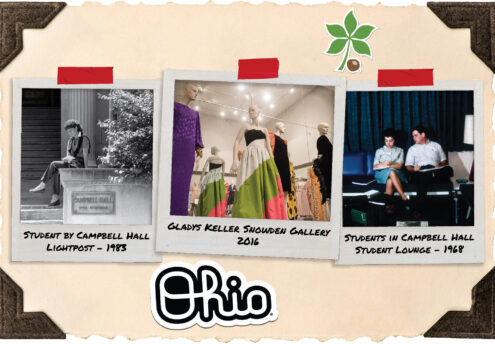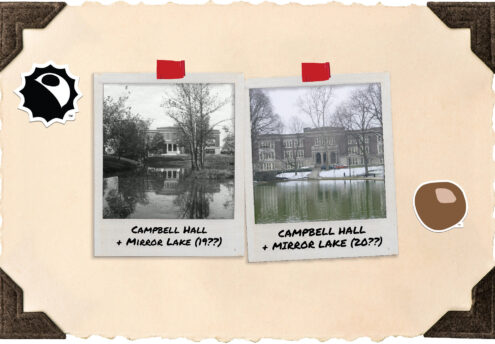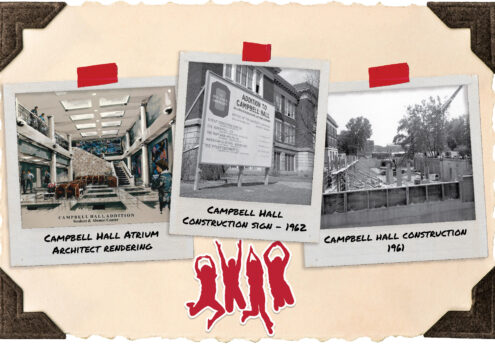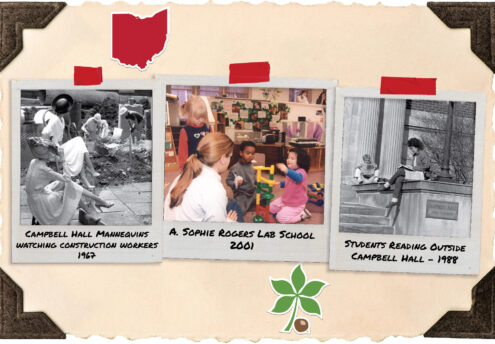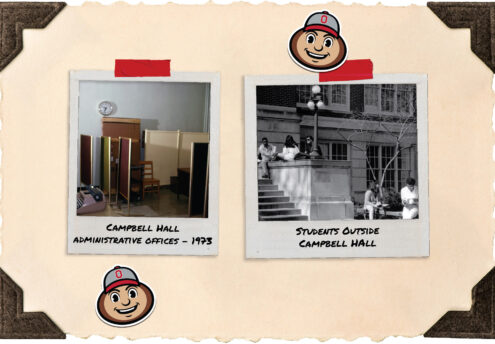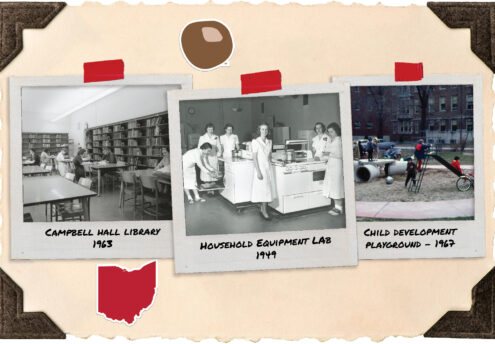For 105 years, an iconic building has stood just beyond the western edge of the Ohio State Oval. With four sets of classical Doric columns adorning its three-arched entry, Campbell Hall endures, overlooking Mirror Lake, refusing to give way to time.
Since September 1916, when classes first assembled in the almost-completed building, Campbell Hall has symbolized opportunity. Its three wings of laboratories, classrooms and home economics library promised the chance for women to earn a college degree, to make new discoveries through academic research, to enter teaching careers and influence lives.
A 1916 report about the College of Agriculture, which housed the program, stated that the new home economics building was one of the largest, most complete of its kind in the United States.
Today, Campbell’s walls hold thousands of memories. Its high-ceiling halls reverberate with echoed voices of students — both male and female — faculty, guests and visiting experts. They specialized in what was first called domestic economy, then domestic art and science, then home economics and now human ecology.
Although the field always focused on the science of better living, it changed from a research focus within the home to the study of the health and economic well-being of individuals, families and communities, with emphasis on the consumer point of view.
As the college looks to a new chapter in Campbell Hall’s story, plans to renovate the stately structure with both state and donor funds are underway.
“This building should be transformative,” Dean Don Pope-Davis said. “A reflection of the values the college embodies.”
Chief of Staff and Director of Strategic Operations Nicole Luthy said the vision is first and foremost to enhance the student experience, starting with those in the college but extending to the many others who attend class in Campbell Hall or stop at the centrally located building to study or meet with fellow students.
In fact, from its earliest days, Campbell Hall’s central place on campus made it a magnet that attracted groups for meetings and events, especially in its auditorium.
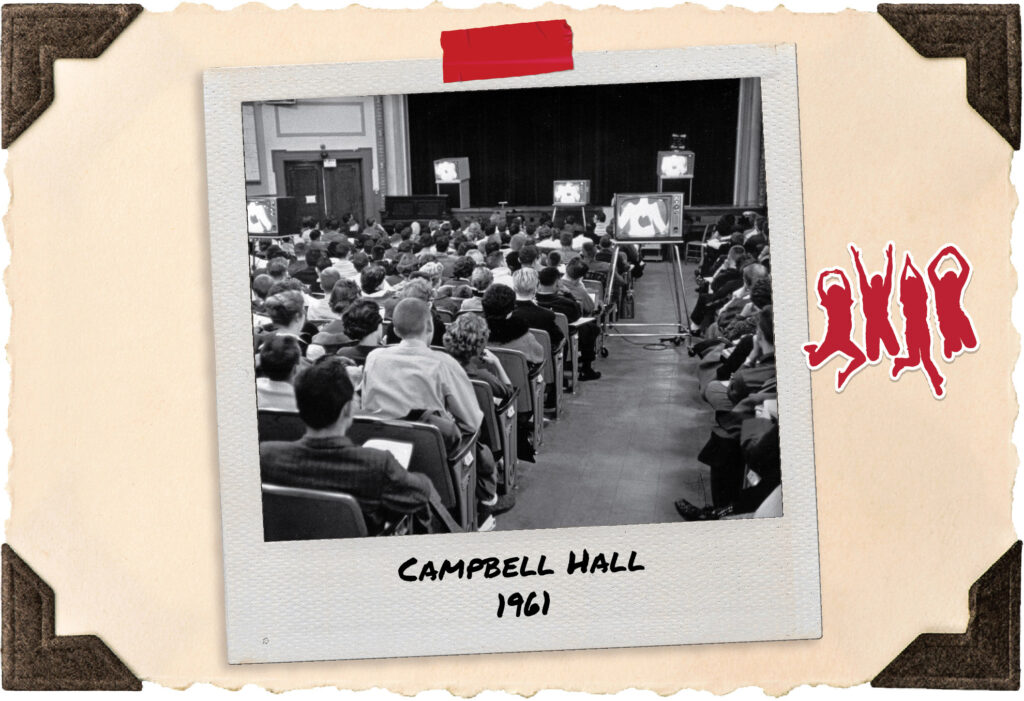
“One objective is to leverage the space to foster creativity, innovation and collaboration for students,” Luthy said. “We want flexible learning and research spaces that function well for our diverse needs, that let us join with more partners to solve complex human problems. To do this, we need modernized wet labs, dry labs, spaces to interview people, a teaching kitchen and more.”
Planning began with focus groups for input, and decisions are yet to be made, but Luthy said the architects are taking a creative approach. They’re focused on using space efficiently as well as upgrading infrastructure, such as heating and air conditioning. Art and artifacts will be incorporated to preserve Campbell Hall’s history and tell the stories of the people whose dreams and careers that it launched.
“We want the space to grow so that 50 years from now, we’ll still be serving the needs of students, faculty and staff,” Luthy said.
While the college’s future in Campbell Hall evolves, here are stories of four alumni and one faculty member who spent time there. They represent the thousands who created the legacy that springs from Campbell Hall.
Alumna turned professor considers herself a boomerang Buckeye

Tasha Lewis, ’98 MS, Textiles and Clothing, describes herself as a boomerang Buckeye, drawn inexorably back to Ohio State not once, but twice, after completing her 1995 bachelor’s in Spanish. Two courses in fashion during her senior year served as the impetus to return.
“My master’s program was my first foray into researching fashion as a scholar,” she said. “It has been foundational to my academic career.”
Lewis describes her two years in Campbell Hall as sometimes nerve-wracking, other times exhilarating. Among the experiences she calls magical, she greeted visitors as a guard to themed exhibits of artifacts from the Historic Costume and Textiles Collection. She sat in the elegant Gladys Keller Snowden Gallery, intrigued by the textiles on display around her.
“We studied the garments, we archived them, we examined their history and culture,” she said. “I was fascinated to learn their stories.”
Another magical moment: she rubbed shoulders with world-famous fashion designer Arnold Scaasi when she helped him install an exhibit of his gowns for a fundraising gala in the Campbell Hall atrium. “It was exciting yet stressful,” she said. “He was very exacting.”
More magic came as deeper aspects of fashion riveted Lewis’ interest. Her professors, with offices along Campbell’s west side, second floor, introduced her to the social responsibility aspect of fashion. In classroom 251, around the corner on Campbell’s south side, lively discussions opened Lewis’ eyes to the idea that clothing should be designed to meet the consumer’s needs.
“I remember interviewing parents in the (A. Sophie Rogers) lab school on the ground floor,” she said. “We were studying color preferences related to gender for children’s clothing.” Their results showed that not all parents wanted to dress their children in stereotypical colors expected for girls and boys.
Farther down the same second floor hall sits Lewis’ old grad student office. It conjured up memories of the fun, often opinionated exchanges she had with her three office mates. In classroom 243, she taught global textile issues, her first experience as a faculty member.
Today, in her second- floor office, along that same hall where her faculty once worked, she is now the first holder of the Nina Mae Mattus Clinical Associate Professorship in Fashion and Retail Studies. One of her research interests is sustainable fashion.
“It was such a valuable experience, being in a program with a focus on more than design: it was science, design, preservation, research. All my learning, all my classes were here in Campbell Hall. It is a fascinating world.”
Campbell Hall launches a 35-year career teaching middle schoolers
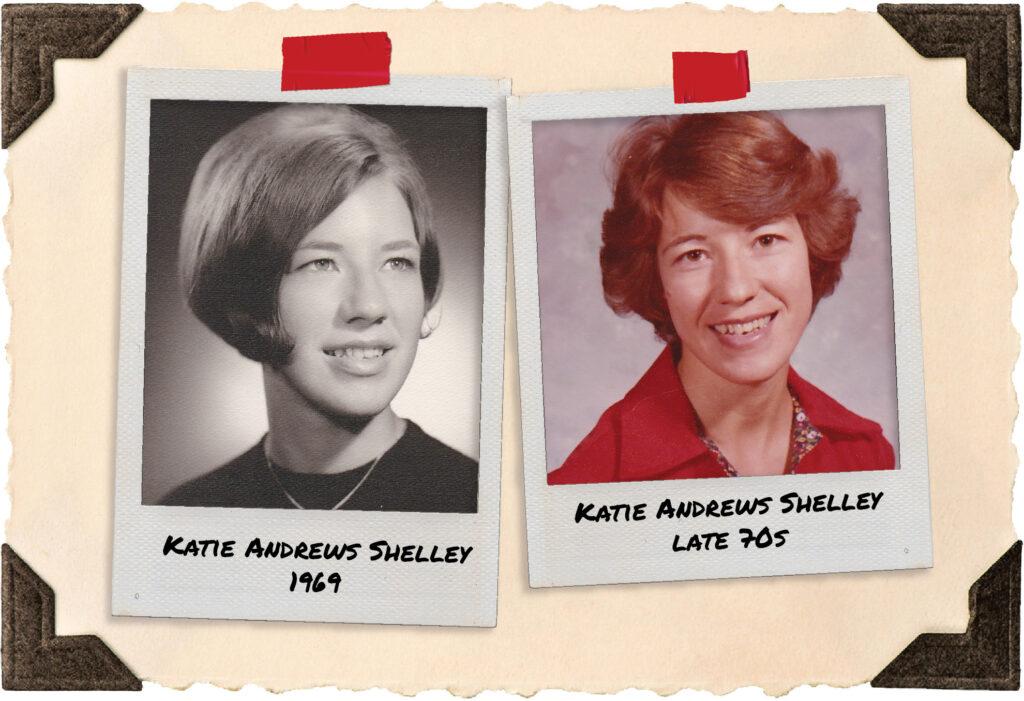
To Katie Andrews Shelley, ’73 BS, ’80 MS, both Home Economics Education, Campbell Hall became a home. Being from a farm family in rural Bellevue, Ohio, the youngest of seven children and not owning a car, she didn’t get home often.
“All my classes were in Campbell,” she said. “They were not lined up, one after another, so rather than hike back to my dorm room, I stayed. This is where I met new people. I could study in the lounge or library (third floor, east side). I could meet with my instructors and collaborate with others.”
She also felt at home because many of her fellow students were also from rural areas. “We bonded because we had similar interests and experiences through 4-H,” she said. “I made a circle of friends to last a lifetime.”
On a recent walk through the venerable old building, room 241 reminded her of a class in home interiors that she took from now deceased Faculty Emerita Velma Everhart.
“I loved that class, but we had to do this giant project,” she said, “to furnish and decorate a room in a cardboard box.” In that time before computer-aided design, students had to find supplies such as small pieces of fabric and wallpaper.
“We pulled all-nighters to get it done,” Shelley said. “So, on the day of class, we turned in our projects, then Professor Everhart turned off the lights to show slides. We immediately fell asleep, and we think she knew we would.”
In 1971, Shelley was selected to join Phi Upsilon Omicron, the family and consumer sciences honorary, often called Phi U.
“They kept white robes for initiation on the ground floor of Campbell,” Shelley said. “We put them on, and we had candles.” They went in solemn procession to a room beside the auditorium still known as the Phi U conference room. “It was a wonderful feeling to be nominated by your faculty for the honor,” she said.
Shelley taught home economics at Bexley Middle School on the east side of Columbus for five years before the prospect of a master’s degree lured her back to Campbell Hall. For two years, she studied while teaching full time and raising a family. Her thesis focused on how to tailor teaching to students with different learning needs.
“Campbell Hall was my ‘go-to’ place,” she said. “I felt welcomed, productive and proud to be a part of all that was happening there, and I still feel that way, many years later.”
Alumna starts degree in Campbell Hall and never looks back
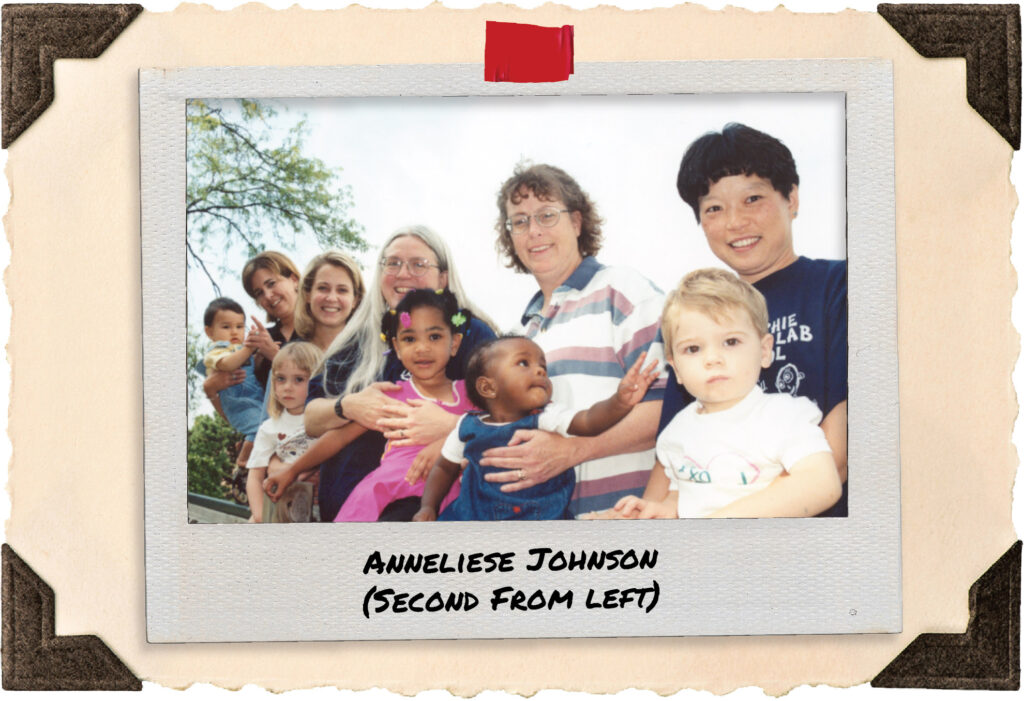
In 1997, Anneliese Wolf Johnson chose early childhood development for her master’s degree in Campbell Hall. Almost 25 years later, she is still with the program, having risen to principal of the college’s A. Sophie Rogers School for Early Learning.
Although the school moved to the college’s Schoenbaum Family Center in Weinland Park in August 2007, Johnson spent 10 years in the preschool on the ground floor of Campbell Hall, which was home to the program since its innovative start as a nursery school in 1925. She sees the building, then and now, as the place that nurtured her as a future leader.
“I was a graduate assistant during my degree and one of the teachers with three-, four- and five-year-olds,” Johnson said. “After I graduated, I was a teacher by day and taught classes in child development in the evenings. As our program has evolved, being able to work with a diverse population of college students and enrolled children has been a big draw in enriching my career.”
Johnson recalls being with the children on the west side playground, “People who worked in the building would say how much they loved looking out and seeing the children playing,” she said.

Johnson appreciated Campbell Hall’s location at the heart of campus. “We would take the children to Mirror Lake to observe and sketch the ducks, or on the Oval to sketch the buildings,” she said. “In the spring, the children would gather bouquets of dandelions. Sadly, dandelions don’t last long in a vase, but it was striking to see the children holding them. It was an immersive learning experience, having those wonderful campus landmarks right there for young children to experience.”
1787 Neil Ave. nurtures a career and a lifelong friendship
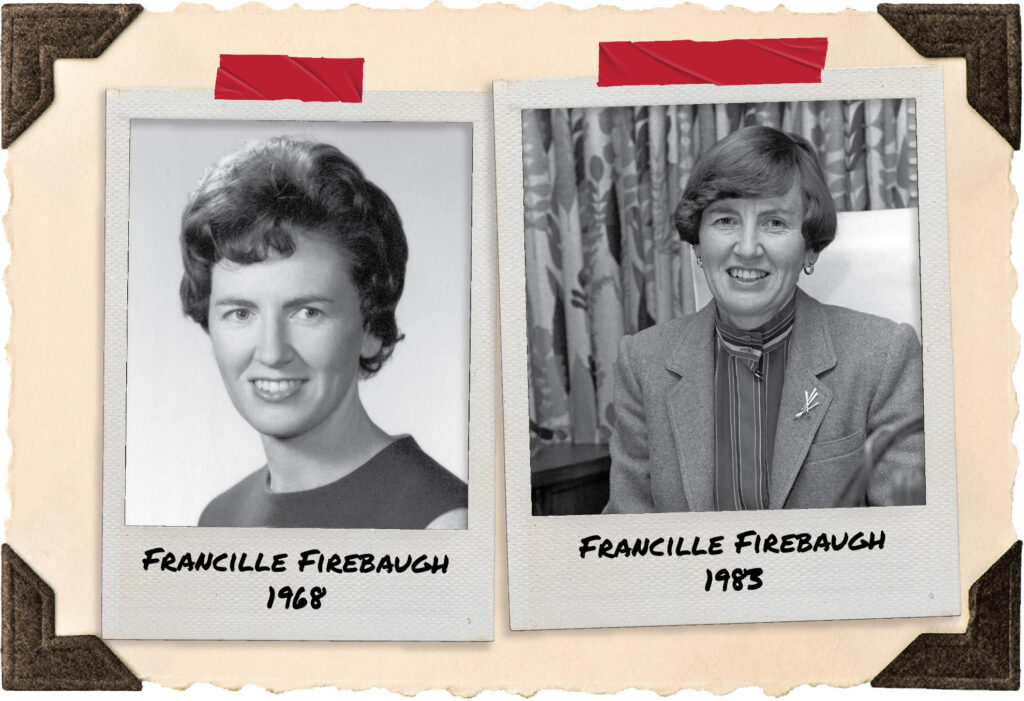
Professor Emerita Francille Maloch Firebaugh found career fulfillment in the building at 1787 Neil Ave., but also something more. With a newly minted doctorate from Cornell University, she entered the halls as a research faculty member in 1962 and was soon teaching graduate students as well.
She remembers Campbell Hall as a welcoming environment. “It was a warm spot,” she said. “One where faculty – a number approaching retirement – were very strong, offering good counsel and encouragement,” she said. “They mentored me in many ways.”
But Firebaugh had set her sights on Ohio State and Campbell Hall for a reason beyond the excellent career opportunity it offered. Before graduating from Cornell, she had heard that Ruth Deacon, a fellow Cornell alumna conducting impactful research, worked there.
“Ruth chaired the Department (of Management, Housing and Equipment), and we shared many interests,” Firebaugh said. “We did research together. We even wrote a textbook or two.” The books proved to be successful; one was updated for a second edition.
Firebaugh progressed in her career until, in 1972, she became director of the School of Home Economics and associate dean of the College of Agriculture and Home Economics. The role took her across campus to the college administrative building. She even served in 1985 as acting vice president for Academic Affairs and provost.
But the bonds nurtured in Campbell Hall lived on in her heart — despite her retirement from Ohio State in 1988, despite moving back to Cornell to be dean of its College of Human Ecology dean, then rising in the administration to vice provost for Land Grant Affairs and special assistant to the president.
The deep friendship between Firebaugh and Deacon, home grown in Campbell Hall, drew the pair back to Columbus in retirement. Today, they celebrate the next generation of experts in family resource management through the Deacon Firebaugh Graduate Fellowship, which they created with family and friends.
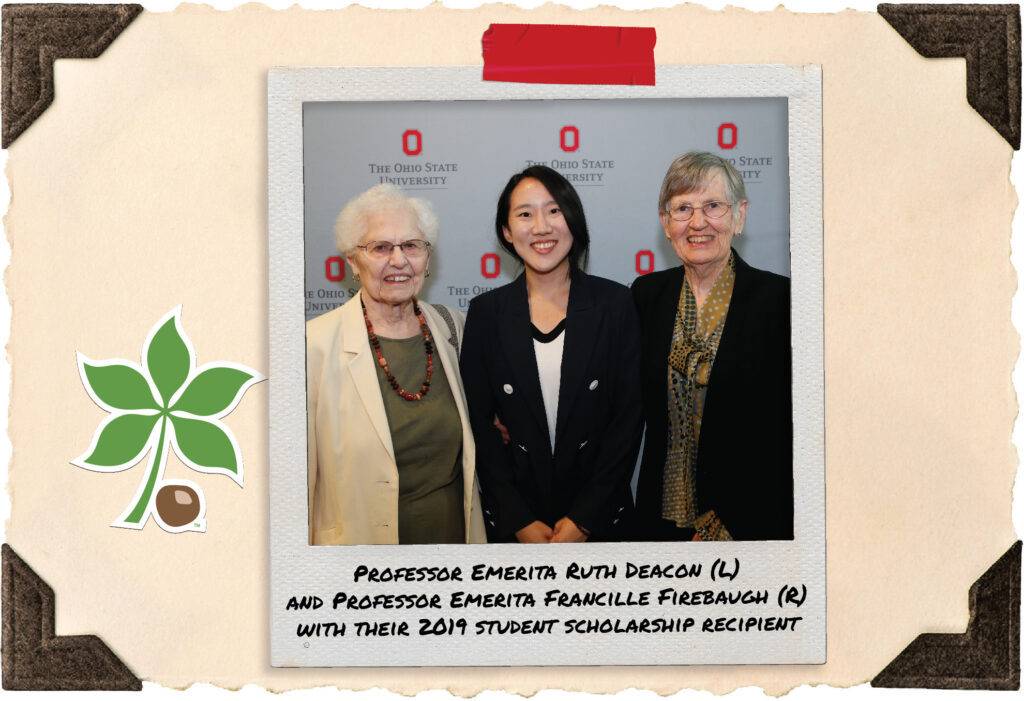
“And thanks to the many years that we’ve known each other, and all our experiences together, we still enjoy our friendship a great deal,” Firebaugh said.
Campbell Hall launches a devoted teacher, an enterprising entrepreneur

Donna Craft Shreiner, ’69 BS Home Economics Education, remembers how impressed she was in autumn 1965 when she first studied in Campbell Hall’s spacious classrooms and laboratories. The 1962 west-side addition was especially modern.
“I came from a poor family,” Shreiner said, “so the appliances in the labs were far superior to what I was used to at home.” Learning in the classroom with the legendary Professor Lena C. Bailey brought her joy.
Bailey, who later became dean and led the School of Home Economics to college status, guided Shreiner and the rest of her students through outlining an entire year of a high school home economics course.
“To teach vocational home economics in Ohio, you had to complete a form showing the basic topics you would teach each week for a year,” Shreiner said. “Some were horrified by the assignment, but I enjoyed it. (Curriculum planning) is my cup of tea.”
Her time spent at Campbell Hall launched Shreiner’s career as a teacher and entrepreneur. She dedicated a year after graduation to students at Upper Scioto Valley High School in McGuffey, Ohio. But in her senior year at Ohio State, she had met David Shreiner, and it proved to be a love match. They married the summer of 1970, and she joined him in Holmes County, on his dairy farm.
Shreiner then enjoyed teaching for six years at Hiland High School in Berlin. “My Hiland Future Homemakers of America Chapter was outstanding in its activities,” she said. “They won many state awards.”
Despite the pleasure of teaching, Shreiner found that the growing family shoe sole business needed her, so she joined, doing accounting and human resources. Yet her degree experience demanded an outlet as well.
“In 1981, I bought a fabric store in Berlin and ran it for 15 years,” she said. “I hired a former student to manage the day-to-day operations. It was my ‘hobby’ as I continued to work in the family business.”
She sold the store in 1996 and retired from the family business in 2019. “But I have never forgotten how the faculty and Campbell Hall launched my career,” she said.
Renovations on Campbell Hall are slated to begin in mid-2023. If you would like to visit the building, we encourage you to plan accordingly.
